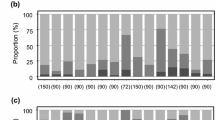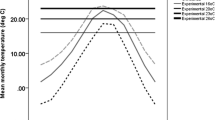Abstract
Spatial or temporal differences in environmental variables, such as temperature, are ubiquitous in nature and impose stress on organisms. This is especially true for organisms that are isothermal with the environment, such as insects. Understanding the means by which insects respond to temperature and how they will react to novel changes in environmental temperature is important for understanding the adaptive capacity of populations and to predict future trajectories of evolutionary change. The organismal response to heat has been identified as an important environmental variable for insects that can dramatically influence life history characters and geographic range. In the current study we surveyed the amount of variation in heat tolerance among Drosophila melanogaster populations collected at diverse sites along a latitudinal gradient in Argentina (24°–38°S). This is the first study to quantify heat tolerance in South American populations and our work demonstrates that most of the populations surveyed have abundant within-population phenotypic variation, while still exhibiting significant variation among populations. The one exception was the most heat tolerant population that comes from a climate exhibiting the warmest annual mean temperature. All together our results suggest there is abundant genetic variation for heat-tolerance phenotypes within and among natural populations of Drosophila and this variation has likely been shaped by environmental temperature.




Similar content being viewed by others
References
Anderson A, Collinge J, Hoffmann AA, Kellett M, McKechnie SW (2003) Thermal tolerance trade-offs associated with the right arm of chromosome 3 and marked by the hsr-omega gene in Drosophila melanogaster. Heredity 90:195–202
Ayrinhac A, Debat V, Gibert P, Kister A, Legout H, Moreteau B, Vergillino R, David J (2004) Cold adaptation in geographical populations of Drosophila melanogaster: phenotypic plasticity is more important than genetic variability. Funct Ecol 18:700–706
Azevedo RBR, French V, Partridge L (1996) Thermal evolution of egg size in Drosophila melanogaster. Evolution 50:2338–2345
Bubliy OA, Riihimaa A, Norry FM, Loeschcke V (2002) Variation in resistance and acclimation to low temperature stress among three geographical strains of Drosophila melanogaster. J Therm Biol 27:237–344
Clarke A (1996) Climate change and animal distributions. In: Johnston IA, Bennett AF (eds) Animals and temperature: phenotypic and evolutionary adaptation. Cambridge University Press, Cambridge, pp 377–407
Cossins AR, Bowler K (1987) Temperature biology of animals. Chapman & Hall, New York
David JR, Capy P (1988) Genetic variation of Drosophila melanogaster natural populations. Trends Genet 4:106–111
David JR, Gibert P, Moreteau B, Gilchrist GW, Huey RB (2003) The fly that came in from the cold: geographic variation of recovery time from low-temperature exposure in Drosophila subobscura. Funct Ecol 17:425–430
David JR, Gibert P, Legout H, Petavy G, Capy P, Moreteau B (2005) Isofemale lines in Drosophila: an empirical approach to quantitative trait analysis in natural populations. Heredity 94:3–12
Davidson JK (1990) Nonparallel geographic patterns for tolerance to cold and desiccation in Drosophila melanogaster and Drosophila simulans. Aust J Zool 38:155–161
Folguera G, Cebalos S, Spezzi L, Fanara JJ, Hasson E (2008) Clinal variation in developmental time and viability, and the response to thermal treatments in two species of Drosophila. Biol J Linn Soc 95:233–245
Gibert P, Huey RB (2001) Chill-coma temperature in Drosophila: effects of developmental temperature, latitude, and phylogeny. Physiol Biochem Zool 74:429–434
Gibert P, Moreteau B, Petavy G, Karan D, David JR (2001) Chill-coma tolerance, a major climatic adaptation among Drosophila species. Evolution 55:1063–1068
Gilchrist GW, Huey RB (1999) The direct response of Drosophila melanogaster to selection on knockdown temperature. Heredity 83:15–29
Gilchrist AS, Partridge L (1999) A comparison of the genetic basis of wing size divergence in three parallel body size clines of Drosophila melanogaster. Genetics 153:1775–1787
Hoffmann AA, Parsons PA (1991) Evolutionary genetics of environmental stress. Oxford University Press, Oxford
Hoffmann AA, Watson M (1993) Geographical variation in the acclimation responses of Drosophila to temperature extremes. Am Nat 142:93–113
Hoffmann AA, Willi Y (2008) Detecting genetic responses to environmental change. Nat Rev Genet 9:421–432
Hoffmann AA, Anderson AR, Hallas R (2002) Opposing clines for high and low temperature resistance in Drosophila melanogaster. Ecol Lett 5:614–618
Hoffmann AA, Sorensen JG, Loeschcke V (2003a) Adaptation of Drosophila to temperature extremes: bringing together quantitative and molecular approaches. J Therm Biol 28:175–216
Hoffmann AA, Hallas RJ, Dean JA, Schiffer M (2003b) Low potential for climatic stress adaptation in rainforest Drosophila species. Science 301:100–102
Hoffmann AA, Shirriffs J, Scott M (2005) Relative importance of plastic vs genetic factors in adaptive differentiation: geographical variation for stress resistance in Drosophila melanogaster from eastern Australia. Funct Ecol 19:222–227
IPCC Report (2007) Climate change 2007: physical science basis. Summary for policy makers approved at the 10th session of Working Group I at the IPCC. IPCC, Paris, Feb 2007
Jenkins NL, Hoffmann AA (1994) Genetic and maternal variation for heat resistance in Drosophila from the field. Genetics 137:783–789
Jentsch A, Kreyling J, Beierkuhnlein C (2007) A new generation of climate-change experiments: events, not trends. Front Ecol Environ 5:365–374
Karan D, David JR (2000) Cold tolerance in Drosophila: adaptive variations revealed by the analysis of starvation survival reaction norms. J Therm Biol 25:345–351
Lavagnino J, Anholt RRH, Fanara JJ (2008) Variation in genetic architecture of olfactory behavior among wild-derived populations of Drosophila melanogaster. J Evol Biol 21:988–996
Leather S, Walter K, Bale J (1993) The ecology of insects overwintering. Cambridge University Press, Cambridge
Loeschcke V, Krebs RA (1996) Selection for heat-shock resistance in larval and in adult Drosophila buzzattii: comparing direct and indirect responses. Evolution 50:2354–2359
Loeschcke V, Krebs RA, Dahlgaard J, Michalak P (1997) High-temperature stress and the evolution of thermal resistance in Drosophila. EXS 83:175–190
Mitchell KA, Hoffmann AA (2010) Thermal ramping rate influences evolutionary potential and species differences for upper thermal limits in Drosophila. Funct Ecol 24:694–700
Morgan TJ, Mackay TFC (2006) Quantitative trait loci for thermotolerance phenotypes in Drosophila melanogaster. Heredity 96:232–242
Parsons PA (1977) Resistance to cold temperature stress in populations of Drosophila melanogaster and Drosophila simulans. Aust J Zool 25:693–698
Potvin C, Tousignant D (1996) Evolutionary consequences of stimulated global change: genetic adaptation or adaptive phenotypic plasticity. Oecologia 108:683–693
Rako L, Blacket MJ, McKechnie W, Hoffmann AA (2007) Candidate genes and thermal phenotypes: identifying ecological important genetic variation for thermotolerance in the Australia Drosophila melanogaster cline. Mol Ecol 16:2948–2957
Rashkovetsky E, Iliadi K, Michalak P, Lupu A, Nevo E, Feder ME, Korol A (2006) Adaptive differentiation of thermotolerance in Drosophila along a microclimatic gradient. Heredity 96:353–359
Reusch TBH, Wood TE (2007) Molecular ecology of global change. Mol Ecol 16:3973–3992
Rohmer C, David JR, Moreteau B, Joly D (2004) Heat induced male sterility in Drosophila melanogaster: adaptive genetic variations among geographic populations and role of the Y chromosome. J Exp Biol 207:2735–2742
SAS Institute (2009) SAS/STAT 9.2 user’s guide, 2nd edn. SAS Institute, Cary
Stanley SM, Parsons PA (1981) The response of the cosmopolitan species, Drosophila melanogaster, to ecological gradients. Proc Ecol Soc Aust 11:121–130
Umina PA, Weeks AR, Kearney MR, McKechnie SW, Hoffmann AA (2005) A rapid shift in a classic clinal pattern in Drosophila reflecting climate change. Science 308:691–693
Zhen Y, Ungerer MC (2008) Clinal variation in freezing tolerance among natural accessions of Arabidopsis thaliana. New Phytol 177:419–427
Acknowledgments
We thank S. Menon for assistance with flies used in this study. This paper was greatly improved by the helpful comments of R.A. Krebs, R.C. Woodruff, and two anonymous reviews. This work was supported by grants from the US National Science Foundation (IOS-1051770), the KSU Ecological Genomics Institute, the KSU Arthropod Genomics Center to TJM and fellowships (NSF GK-12 and GAANN) to LCF.
Author information
Authors and Affiliations
Corresponding author
Rights and permissions
About this article
Cite this article
Fallis, L.C., Fanara, J.J. & Morgan, T.J. Genetic variation in heat-stress tolerance among South American Drosophila populations. Genetica 139, 1331–1337 (2011). https://doi.org/10.1007/s10709-012-9635-z
Received:
Accepted:
Published:
Issue Date:
DOI: https://doi.org/10.1007/s10709-012-9635-z




